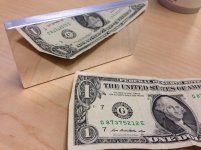Mill it, chuck your indicator in the dustbin and buy a optical flat, then compare it to a ground surface and get back to us. Let us know how well you do were each of your cutter stripes are. Stop mistaking shiny for flat, its not it just does not work that way and never has, oh and the indicator in the machine that just milled it proves only that your machine can repeat the same movement errors really well! Still does not nore ever shall make for a part thats actually milled flat to 2 tenths even if you could write the G code to do so!
Yup.
"Shiny" is not a metric of anything.
^^^ Just to mess with people's heads a bit the work of Masao Yamaguchi …
Ultra precise grinder but also the effect of structured patterns and cutter geometry. + Awesome coin trick on grinding machine.
__________________________________________________ __________________________________________________ _
Even a machine like a Mazak Variaxis (and many others) is capable of imparting a freakishly smooth surface (for example to aluminum) with a high degree of specular reflection from certain angles and has a freakish feel to it (almost ceramic / gloss like texture) when you run your finger nail over the surface. BUT that sure as hell
does not mean that the surface is actually flat and does not have a significant wave in it also (like what
Adama is saying) . A lot of modern CNC machines can do that routinely... It's not necessarily a surface property that is advantageous to surfaces whose surfaces are actually functional (i.e. they do something other than looking "pretty" or "Shiny" (in this case)) .
I would have thought if one is building machines form cast iron and scraping and grinding is not used , then one would think that a surface that has accurate hills and accurate valleys (statistical distribution) , (as a result of face milling on an accurate stable machine), these micro hills and valleys comprising the exposed surface would be better for mating contact surfaces as the milled pattern will or could be made to "Key" better to each other, i.e. create a better more stable joint when bolted together and won't wander during service life from vibrations and bumps and crashes (as compared to a "slippery"/low friction surface) ?
Even good grinding equipment will put a wave into a surface.
__________________________________________________________________________________________________
I still feel like I have 25 years of machining "technique" to catch up on but I don't understand why cutter geometry and coatings and materials are not "discussed" / mentioned (by OP/ Mr Tomb in this case)? [usually stuff has to be reduced (in some cases) to a single point cutter type problem. I thought the wiper technique for shell mills required also one of the inserts to be a "smidge" proud of the other inserts ? Which means the other inserts have to be set very carefully too and the mill trammed in perfectly (so you are not cutting a dish in the surfaces etc.)] ?
Normally to analyze a surface in terms of flatness versus roughness and surface texture , best mathematical technique uses Fourier transforms
, so flatness versus "Partical size" and frequency response can be determined over 100mm, 10 mm, 1 mm, 0.1 mm, 0.01 mm, 0.001 mm , 0.0001 mm etc. There's a whole range of ways to do that beyond the use of a profilometer.
_________________________________________________________________________________________________
Like what Adama says a wave plate brings a rather unforgiving reality to things … You can't BS a waveplate lol. Raw physics kinda trumps cherry picked data neatly arranged in paginated rows and columns stored on a computer.





